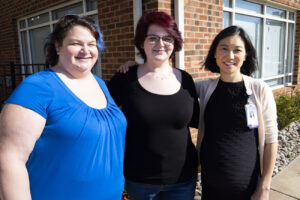Coryzma experienced seizures for years before receiving a diagnosis. She described her seizures as feeling like déjà vu and at one point, Coryzma was having about five seizures a day, many times blacking out completely. Finally in seventh grade, Coryzma was diagnosed with epilepsy.
Coryzma’s mother, Christina, chose to go to the UNC Epilepsy Center for treatment. The most common treatment method for epilepsy is medication, which can effectively control seizures for many patients. Unfortunately, the medications did little to control the frequency of Coryzma’s seizures. “I had to switch medications a lot,” recalled Coryzma. After Coryzma tried several medications, which caused frustrating side effects without success, her doctors at the UNC Epilepsy Center began evaluating her for epilepsy surgery.
medication, which can effectively control seizures for many patients. Unfortunately, the medications did little to control the frequency of Coryzma’s seizures. “I had to switch medications a lot,” recalled Coryzma. After Coryzma tried several medications, which caused frustrating side effects without success, her doctors at the UNC Epilepsy Center began evaluating her for epilepsy surgery.
With stereotactic encephalography (sEEG) and specialized brain imaging, the team identified that the seizures were coming from the left temporal lobe, an area of the brain where language and memory lives. “For epilepsy surgery, it’s weighing the benefits and risks – of seizure freedom versus the risk of creating a new functional deficit due to surgery,” said UNC pediatric neurosurgeon Dr. Scott Elton. “All of this is discussed with the family.”
“She had no energy or drive to do anything else. Appointments were exhausting for her. She didn’t want to participate with the family, go out, or partake in activities.”
Since the seizures were coming from a sensitive area of the brain, the team recommended implanting a neuro-modulation device to try and control Coryzma’s seizures. During her first consultation with Dr. Elton, Coryzma felt at ease about the surgery. “He is really easy to talk to,” said Coryzma. “He is very reassuring.”

Coryzma’s first surgery took place in January 2019. However, after surgery, Coryzma’s seizures came back and the device had to be removed due to infection. At this point, Coryzma was still taking seizure medications and experiencing many side effects. This made it impossible for Coryzma to drive or get a job. Day to day life was becoming difficult as she struggled with anxiety and depression caused by her frequent seizures and medications. “She slept literally all day,” said Coryzma’s mother, Christina. “She had no energy or drive to do anything else. Appointments were exhausting for her. She didn’t want to participate with the family, go out, or partake in activities.”
It was back to the drawing board for the UNC Epilepsy Center team. “Epilepsy treatment is really a team sport,” said Dr. Elton. In 2021, Coryzma consulted with pediatric epileptologist Dr. Qian-Zhou (JoJo) Yang. “Coryzma had a thorough evaluation with intracranial EEG in 2018 to locate the seizures,” said Dr. Yang, Director of the UNC Pediatric Epilepsy Monitoring Unit. “We were able to look back at these EEGs and see that the seizures were in fact coming from a very small part at the bottom of the left temporal lobe. This area was not close to language or memory functions.”
The UNC Epilepsy Center regularly holds internal conference meetings with each specialist present to discuss patient cases and to determine the best treatment for each patient. After reviewing all of Coryzma’s MRI and PET exams, pediatric neuroradiologist Dr. Sheng-Che (Alex) Hung identified the abnormal brain region that matched the EEG abnormality found by Dr. Yang. Dr. Hung also evaluated the relationship between the abnormal brain region and the optic radiation using diffusion-tensor imaging and helped locate the target region on the navigation system. After thorough consideration, the multidisciplinary team recommended a surgical removal of this small area of the left inferior temporal lobe, which would minimize the risk of any deficit to language or memory.
would minimize the risk of any deficit to language or memory.
After years of seizures and dealing with debilitating anxiety and depression caused by medications, Coryzma was ready to try the surgery. “They told us the possible outcomes, possible therapies that may be needed after surgery,” recalled Christina. “We had to take time to process the information. It was very overwhelming. Coryzma was mostly on board just for the hope of being seizure-free.”
Coryzma’s resection surgery took place in December 2021. Dr. Elton also performed a cranioplasty to replace the part of the skull that was lost due to infection. The surgery went extremely well without any complications. Coryzma stayed in the hospital for less than a week before being discharged. “Things could not have been more perfect,” said Christina. “Her recovery was smooth and relatively quick considering what she had been through. No therapies were needed. We came off one of her meds, which was when we saw the big change.”
Coryzma also noted that all of the nurses and staff went out of their way to make her stay in the hospital as comfortable as possible. “They made sure everything was easy on my mom and made sure that she could relax,” said Coryzma. “They were all very sweet.”
“Of all the possible outcomes, we couldn’t have asked for a better one.”

After surgery, Coryzma was able to cut her seizure medications in half and stop her anti-depressant. “Our goal with epilepsy surgery is to be precise and accurate in identifying where the seizures come from,” said Dr. Yang. “This gives the best outcome in terms of seizure control.” Her care team at the UNC Epilepsy Center describe her as a completely different girl than she was before her last surgery. “Dr. Yang makes sure that I know everything I need to know when I go into my appointments,” said Coryzma.
During Coryzma’s last appointment with Dr. Yang, she was cleared to drive. Now that she is over one year seizure free, she has her first job. “We’ve got our girl back,” said Christina. “She has drive, energy, sassiness. She wants to go back to school, work, and start being part of the family again. She’s back to being an active teenager.”
Coryzma now has the rest of her life to look forward to, without frequent seizures getting in her way. “She is the girl we knew before,” said Christina. “Of all the possible outcomes, we couldn’t have asked for a better one.”
Written by: Makenzie Hardy, Marketing Coordinator, UNC Health Department of Neurosurgery